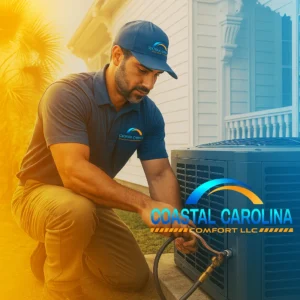Calibrating your AC thermostat isn’t rocket science, but it can feel like a walk through a tech maze. You’ll need a trusty thermometer, a screwdriver, and a bit of patience. First off, find your thermostat. It’s probably acting all high and mighty on a wall somewhere. Avoid the temptation to place it near windows or doors; we’re calibrating, not trying to catch a draft. Next, dive into the guts of the beast with your screwdriver. A twist here, a turn there, aiming for that sweet spot where your room doesn’t feel like a sauna or an igloo. Compare the readings with your thermometer. Congrats, you’re on your way to mastering the art of the perfect indoor climate. Stick with us, and you’ll learn even more tricks to tame your thermostat’s temperament.
Understanding Thermostat Calibration
Before you dive headfirst into the mysterious world of thermostat calibration, let’s get one thing straight: it’s not rocket science, but it sure can feel like it.
You’re not alone if the thought of tweaking your AC thermostat’s settings sends you into a mild panic. But hey, who doesn’t enjoy a good temperature challenge?
Understanding the ins and outs of calibration is all about getting cozy with two main stars: temperature sensitivity and calibration frequency.
Think of your thermostat as a moody artist who needs regular check-ins to ensure it’s still in tune with reality. You wouldn’t want your AC playing summer hits in the middle of winter, right?
Identifying Calibration Issues
Now that you’re a budding thermostat whisperer, let’s tackle how to spot when your trusty device starts acting more like a diva on a bad day.
First off, if your living room feels more like a sauna while your thermostat smugly claims it’s a cool 68 degrees, you’ve got yourself a classic case of temperature discrepancies. This is one of those tell-tale calibration symptoms, shouting louder than a teen at a boy band concert that something’s off.
Also, if your energy bill has suddenly skyrocketed without any logical reason, your thermostat might just be fibbing about its accuracy.
Lastly, if adjusting the temperature feels like sending a text to someone who’s ghosting you—no response—it’s high time for a calibration intervention.
Professional AC Thermostat Repair Services
Tools Required for Calibration
You’ll need a handful of gadgets that don’t require a degree in rocket science to use, to get your thermostat back in line. Here’s what you’re signing up for:
- Reliable thermometer: Because guessing the temperature is about as effective as trying to taste colors.
- Screwdriver set: You’re not cracking a vault, but you’ll feel just as victorious when you’re done.
- Calibration standards manual: Think of it as the treasure map to the lost city of Perfect Temperature.
Arming yourself with these tools is your first step in the noble quest of temperature measurement mastery. And remember, calibration standards aren’t just fancy words; they’re your guiding stars. Welcome to the club of thermostat whisperers.
Accessing the Thermostat
Armed with your trusty tools, it’s time to get up close and personal with your thermostat, the gatekeeper of your comfort zone. Locating this little wizard isn’t rocket science, but it does require a keen eye. Most thermostats enjoy basking in the glory of wall-mounted visibility, often in living rooms or hallways. Remember, it’s all about location, location, location!
Avoid the rookie mistake of thermostat placement near windows or doors, as drafts can trick it into thinking it’s hotter or colder than it really is. When it comes to installation tips, think of it as hanging a precious piece of art. You wouldn’t put the Mona Lisa just anywhere, right? Treat your thermostat with the same reverence, ensuring it’s securely fastened and accessible for those moments of temperature diplomacy.
Adjusting the Calibration Settings
Diving into the heart of your AC’s mind, adjusting the calibration settings is like teaching an old dog new tricks, but fear not, it’s simpler than you think. Here’s how you can tweak those settings to make your AC learn some new temperature sensitivity tricks:
- Locate the calibration screw – it’s the little-known hero of thermostat accuracy.
- Turn it clockwise for higher sensitivity; this tells your AC to pay more attention to room changes. A must-have during those unpredictable weather episodes.
- Counterclockwise makes it less sensitive; perfect for when you’re tired of your AC overreacting like a drama queen every time someone opens the door.
Calibration benefits? More comfort, less energy waste, and finally feeling like you belong in the Goldilocks zone of ‘just right’ temperatures.
Testing the Thermostat Accuracy
Now that you’ve played mad scientist with your thermostat’s calibration settings, it’s time to see if your AC’s got its degree in accuracy or if it’s still guessing temperatures like a confused chameleon in a color maze.
Grab a reliable thermometer and park it right next to your thermostat. Give it some time to get acquainted and then compare notes. If the numbers are singing in harmony, you’re in tune. But if you’re spotting temperature discrepancies wider than the gap in a teenager’s front teeth, you’ve got some fine-tuning to do.
Maintaining Optimal Performance
Regularly checking your AC’s performance is like giving it a pep talk; it ensures it’s always ready to beat the heat with gusto. Here’s how you keep your cool companion fighting fit:
- Clean or Replace Filters: Dirt is the enemy! A clean filter means your AC doesn’t break a sweat pumping out chilled air.
- Seal Those Leaks: Drafty windows and doors are like energy vampires for your AC. Seal them up to boost energy savings and keep the cool where it belongs.
- Schedule Professional Tune-ups: Sometimes, you’ve gotta call in the pros. An annual check-up can work wonders for comfort optimization and keeping those utility bills in check.
Frequently Asked Questions
Can Fluctuating Power Supply Affect My Thermostat’s Calibration Over Time?
Yes, fluctuating power supply, especially power surges, can mess with your thermostat’s calibration over time. It’s like voltage stability went on vacation, leaving your AC’s accuracy in limbo. Welcome to the calibration club!
This Question Explores Whether External Electrical Issues Could Impact the Thermostat’s Accuracy and Require More Frequent Recalibrations.
Yes, those pesky external electrical gremlins can indeed mess with your thermostat’s accuracy. A regular wiring inspection and investing in surge protection might save you from those annoying recalibration parties nobody wants to attend.
Are There Specific Brands or Models of Thermostats That Are Known for Holding Their Calibration Longer?
Funny you should ask—yes, some thermostats are like marathon runners; they hold their calibration longer. Check out models with rave reviews for endurance. Pro tip: Arm yourself with installation tips and calibration tools to stay ahead!
This Inquires About the Reliability of Different Thermostat Brands or Models in Maintaining Their Calibration Settings Over Time, Which Might Not Be Covered in a Generic Calibration Guide.
You’re curious about which thermostat brands stay tuned like a finely aged wine, huh? Remember, brand reputation and savvy calibration techniques are your best pals here. Dive in, and let’s keep that cool vibe going!
How Do Seasonal Changes Impact the Need for Thermostat Calibration?
Seasonal changes are like your moody friend: unpredictable. They can throw your thermostat’s calibration out of whack, especially if your home’s insulation quality is more Swiss cheese than fortress, leaving you sniffling with seasonal allergies.
Conclusion
Now that you’ve twisted knobs, flipped switches, and possibly questioned your sanity during the thermostat calibration process, you’re almost an expert.
Remember, a well-calibrated thermostat can save up to 10% on your energy bill annually. That’s enough to buy yourself a celebratory pizza (or a fancy thermostat cover).
Keep your cool—or heat—and enjoy the fruits of your labor. Calibration isn’t just about comfort; it’s about keeping those bills from burning a hole in your wallet.
Stay chill, my DIY friend.


